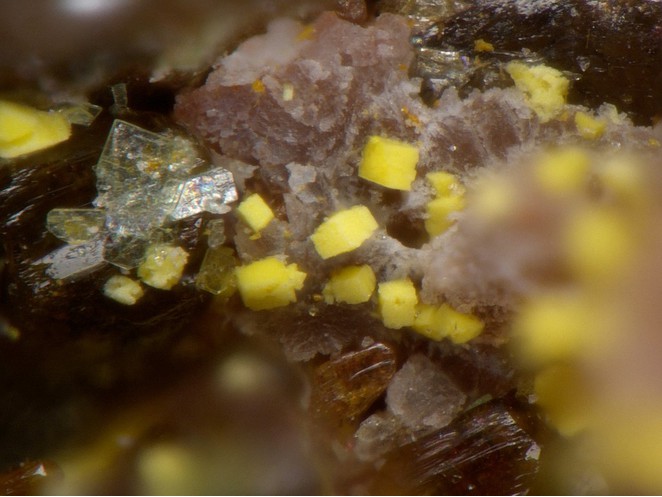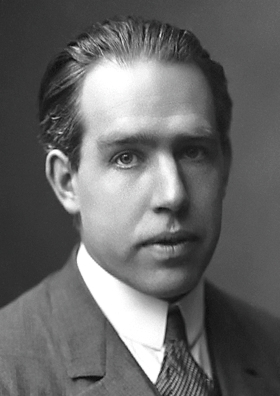Nielsbohrite
A valid IMA mineral species
This page is currently not sponsored. Click here to sponsor this page.
About Nielsbohrite
Formula:
K(UO2)3(AsO4)(OH)4 · H2O
Colour:
Yellow
Lustre:
Vitreous, Dull
Hardness:
2
Specific Gravity:
5.45 - 5.65
Crystal System:
Orthorhombic
Name:
After Niels Henrik David Bohr (Copenhagen 7 October 1885 - idem 18 November 1962), Danish physicist. He contributed to understanding atomic structure and quantum mechanics. He received the Nobel Prize in Physics in 1922. Bohr mentored and collaborated with many of the top physicists of the century at his institute in Copenhagen. He was also part of the team of physicists working on the Manhattan Project.
This page provides mineralogical data about Nielsbohrite.
Unique Identifiers
Mindat ID:
32208
Long-form identifier:
mindat:1:1:32208:7
GUID
(UUID V4):
(UUID V4):
4411f29e-5c9e-4e8d-897b-03e2e6764546
IMA Classification of Nielsbohrite
Approved
IMA Formula:
(K,U,◻)(UO2)3(AsO4)(OH)4 · H2O
Approval year:
2007
First published:
2009
Classification of Nielsbohrite
8.ED.20
8 : PHOSPHATES, ARSENATES, VANADATES
E : Uranyl phosphates and arsenates
D : Unclassified
8 : PHOSPHATES, ARSENATES, VANADATES
E : Uranyl phosphates and arsenates
D : Unclassified
42.13.10.
42 : HYDRATED PHOSPHATES, ETC.CONTAINING HYDROXYL OR HALOGEN
13 : Miscellaneous
42 : HYDRATED PHOSPHATES, ETC.CONTAINING HYDROXYL OR HALOGEN
13 : Miscellaneous
Mineral Symbols
As of 2021 there are now IMA–CNMNC approved mineral symbols (abbreviations) for each mineral species, useful for tables and diagrams.
| Symbol | Source | Reference |
|---|---|---|
| Nbr | IMA–CNMNC | Warr, L.N. (2021). IMA–CNMNC approved mineral symbols. Mineralogical Magazine, 85(3), 291-320. doi:10.1180/mgm.2021.43 |
Physical Properties of Nielsbohrite
Vitreous, Dull
Transparency:
Transparent
Colour:
Yellow
Streak:
Yellowish
Hardness:
2 on Mohs scale
Tenacity:
Brittle
Cleavage:
None Observed
Fracture:
Irregular/Uneven
Density:
5.45 - 5.65 g/cm3 (Measured)
Optical Data of Nielsbohrite
Type:
Biaxial (-)
RI values:
nα = 1.756(2) nβ = 1.764(2) nγ = 1.765(2)
2V:
Measured: 35° (5), Calculated: 39°
Max Birefringence:
δ = 0.009

Image shows birefringence interference colour range (at 30µm thickness)
and does not take into account mineral colouration.
and does not take into account mineral colouration.
Surface Relief:
High
Dispersion:
strong r > v
Pleochroism:
Non-pleochroic
Chemistry of Nielsbohrite
Mindat Formula:
K(UO2)3(AsO4)(OH)4 · H2O
Crystallography of Nielsbohrite
Crystal System:
Orthorhombic
Class (H-M):
mmm (2/m 2/m 2/m) - Dipyramidal
Space Group:
Cccm
Setting:
Cccm
Cell Parameters:
a = 8.193(3) Å, b = 11.430(4) Å, c = 13.500(5) Å
Ratio:
a:b:c = 0.717 : 1 : 1.181
Unit Cell V:
1264.1 ų
Z:
4
Morphology:
Rhombohedron-like crystals. Forms include {001}, {100} or {010}, and {210} or {120}.
Crystal Structure
Load
Unit Cell | Unit Cell Packed
2x2x2 | 3x3x3 | 4x4x4
Unit Cell | Unit Cell Packed
2x2x2 | 3x3x3 | 4x4x4
Show
Big Balls | Small Balls | Just Balls | Spacefill
Polyhedra Off | Si Polyhedra | All Polyhedra
Remove metal-metal sticks
Big Balls | Small Balls | Just Balls | Spacefill
Polyhedra Off | Si Polyhedra | All Polyhedra
Remove metal-metal sticks
Display Options
Black Background | White Background
Perspective On | Perspective Off
2D | Stereo | Red-Blue | Red-Cyan
Black Background | White Background
Perspective On | Perspective Off
2D | Stereo | Red-Blue | Red-Cyan
View
CIF File Best | x | y | z | a | b | c
CIF File Best | x | y | z | a | b | c
Rotation
Stop | Start
Stop | Start
Labels
Console Off | On | Grey | Yellow
Console Off | On | Grey | Yellow
Data courtesy of the American Mineralogist Crystal Structure Database. Click on an AMCSD ID to view structure
| ID | Species | Reference | Link | Year | Locality | Pressure (GPa) | Temp (K) |
|---|---|---|---|---|---|---|---|
| 0007287 | Nielsbohrite | Walenta K, Hatert F, Theye T, Lissner F, Roller K (2009) Nielsbohrite, a new potassium uranyl arsenate from the uranium deposit of Menzenschwand, southern Black Forest, Germany European Journal of Mineralogy 21 515-520 | 2009 | Menzenschwand, southern Black Forest, Germany | 0 | 293 |
CIF Raw Data - click here to close
X-Ray Powder Diffraction
Powder Diffraction Data:
| d-spacing | Intensity |
|---|---|
| 6.71 Å | (80) |
| 6.03 Å | (100) |
| 3.78 Å | (70) |
| 3.33 Å | (80) |
| 2.96 Å | (60) |
| 2.88 Å | (40) |
| 2.63 Å | (50) |
| 1.942 Å | (50) |
Geological Environment
Paragenetic Mode(s):
| Paragenetic Mode | Earliest Age (Ga) |
|---|---|
| Stage 7: Great Oxidation Event | <2.4 |
| 47a : [Near-surface hydration of prior minerals] | |
| 47d : [Arsenates, antimonates, selenates, bismuthinates] | |
| Stage 10b: Anthropogenic minerals | <10 Ka |
| 55 : Anthropogenic mine minerals |
Type Occurrence of Nielsbohrite
General Appearance of Type Material:
Euhedral rhombohedron-like crystals to 0.15 mm in size, often altered.
Place of Conservation of Type Material:
Staatliches Museum fur Naturkunde in Stuttgart, Germany, and the single crystal used for the structural study at the Laboratory of Mineralogy, University of Lie`ge, Belgium (no 20355).
Geological Setting of Type Material:
Oxidized uranium deposit.
Associated Minerals at Type Locality:
Reference:
Walenta, K., Hatert, F., Theye, Th., Lissner, F., Roeller, K. (2009): Nielsbohrite, a new potassium uranyl arsenate from the uranium deposit of Menzenschwand in the Southern Black Forest, Germany. European Journal of Mineralogy, 21, 515-520.
Synonyms of Nielsbohrite
Related Minerals - Strunz-mindat Grouping
| 8.ED.05 | Moreauite | Al3(UO2)(PO4)3(OH)2 · 13H2O |
| 8.ED.10 | Asselbornite | Pb(BiO)3(UO2)4(AsO4)2(OH)7 · 4H2O |
| 8.ED.10 | Metalodèvite | Zn(UO2)2(AsO4)2 · 10H2O |
| 8.ED.10 | Šreinite | Pb(BiO)3(UO2)4(PO4)2(OH)7 · 4H2O |
| 8.ED.15 | Kamitugaite | PbAl[(UO2)5(PO4)2.38(AsO4)0.62O2(OH)2] · 11.5H2O |
Fluorescence of Nielsbohrite
none
Other Information
Health Risks:
No information on health risks for this material has been entered into the database. You should always treat mineral specimens with care.
Internet Links for Nielsbohrite
mindat.org URL:
https://www.mindat.org/min-32208.html
Please feel free to link to this page.
Please feel free to link to this page.
Search Engines:
External Links:
References for Nielsbohrite
Reference List:
Localities for Nielsbohrite
Locality List
 - This locality has map coordinates listed.
- This locality has map coordinates listed.
 - This locality has estimated coordinates.
ⓘ - Click for references and further information on this occurrence.
? - Indicates mineral may be doubtful at this locality.
- This locality has estimated coordinates.
ⓘ - Click for references and further information on this occurrence.
? - Indicates mineral may be doubtful at this locality.
 - Good crystals or important locality for species.
- Good crystals or important locality for species.
 - World class for species or very significant.
(TL) - Type Locality for a valid mineral species.
(FRL) - First Recorded Locality for everything else (eg varieties).
- World class for species or very significant.
(TL) - Type Locality for a valid mineral species.
(FRL) - First Recorded Locality for everything else (eg varieties).
All localities listed without proper references should be considered as questionable.
Germany (TL) | |
|
Quick NavTopAbout NielsbohriteUnique IdentifiersIMA Classification Classification Mineral SymbolsPhysical Properties Optical Data Chemistry Crystallography Crystal StructureX-Ray Powder DiffractionGeological EnvironmentType Occurrence SynonymsStrunz-MindatFluorescence Other InformationInternet Links References Localities Locality List




 symbol to view information about a locality.
The
symbol to view information about a locality.
The 



Krunkelbach Valley Uranium deposit, Menzenschwand, St Blasien, Waldshut, Freiburg Region, Baden-Württemberg, Germany